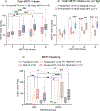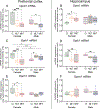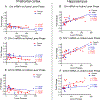Sex- and Brain Region-specific Changes in Gene Expression in Male and Female Rats as Consequences of Methamphetamine Self-administration and Abstinence
- PMID: 33242543
- PMCID: PMC8175033
- DOI: 10.1016/j.neuroscience.2020.11.025
Sex- and Brain Region-specific Changes in Gene Expression in Male and Female Rats as Consequences of Methamphetamine Self-administration and Abstinence
Abstract
Sex differences in METH use exist among human METH users and in animal models of METH addiction. Herein, we tried to identify potential differences in gene expression between female and male rats after Methamphetamine self-administration (METH SA). Rats were trained to self-administer METH using two 3-hours daily sessions for 20 days. Cue-induced drug seeking was measured on withdrawal days 3 (WD3) and 30 (WD30). Rats were euthanized twenty-four hours after WD30. Prefrontal cortex (PFC) and hippocampus (HIP) were dissected to measure mRNA expression. Both female and male rats increased their METH intake and showed increased METH seeking during withdrawal. Female had higher basal level expression of hypocretin receptor 1 (Hcrtr1) and prodynorphin (Pdyn) mRNAs in the PFC and HIP. Basal corticotropin releasing hormone receptor 1 (Crhr1), Crh receptor 2 (Crhr2), hypocretin receptor 2 (Hcrtr2) and opioid receptor kappa 1 (Oprk1) mRNA levels were higher in the PFC of females. Male rats had higher basal levels of Crh and Crhr1 in HIP. METH SA was associated with increased Crh and Crhr1 in the HIP of both sexes and Crhr2 only in female HIP. Importantly, increased Crh and Crhr1 mRNA levels correlated positively with incubation of METH craving in both sexes, supporting their potential involvement, in part, in the regulation of this behavioral phenomenon. When taken together, our results identified sexual dimorphic baseline differences in rats. We also detected dimorphic responses in animals that had self-administered METH. These observations highlight the importance of understanding the molecular neurobiology of sex differences when therapeutic interventions are planned against METH addiction.
Keywords: Methamphetamine self-administration; addiction; hippocampus; prefrontal cortex; sexual dimorphism.
Published by Elsevier Ltd.
Conflict of interest statement
CONFLICT OF INTEREST
The authors declare that they have no conflict of interest.
Figures









Similar articles
-
Sex Differences in Escalated Methamphetamine Self-Administration and Altered Gene Expression Associated With Incubation of Methamphetamine Seeking.Int J Neuropsychopharmacol. 2019 Nov 1;22(11):710-723. doi: 10.1093/ijnp/pyz050. Int J Neuropsychopharmacol. 2019. PMID: 31562746 Free PMC article.
-
Sex-specific Alterations in the mRNA Expression of Histone Deacetylases (HDACs) in the Rat Brain Following Prolonged Abstinence from Methamphetamine Self-administration.Mol Neurobiol. 2025 Aug;62(8):9759-9771. doi: 10.1007/s12035-025-04869-7. Epub 2025 Mar 28. Mol Neurobiol. 2025. PMID: 40148576
-
RNA sequencing analysis identifies sex differences in transcriptional signatures in the dorsal striatum of female and male rats after withdrawal from methamphetamine self-administration.Neurochem Int. 2025 Jul;187:105980. doi: 10.1016/j.neuint.2025.105980. Epub 2025 Apr 23. Neurochem Int. 2025. PMID: 40280491
-
Neural mechanisms underlying incubation of methamphetamine craving: A mini-review.Pharmacol Biochem Behav. 2020 Dec;199:173058. doi: 10.1016/j.pbb.2020.173058. Epub 2020 Oct 23. Pharmacol Biochem Behav. 2020. PMID: 33250444 Free PMC article. Review.
-
Sex differences in methamphetamine use disorder perused from pre-clinical and clinical studies: Potential therapeutic impacts.Neurosci Biobehav Rev. 2022 Jun;137:104674. doi: 10.1016/j.neubiorev.2022.104674. Epub 2022 Apr 20. Neurosci Biobehav Rev. 2022. PMID: 35452744 Free PMC article. Review.
Cited by
-
Escalated Oxycodone Self-Administration Is Associated with Activation of Specific Gene Networks in the Rat Dorsal Striatum.Int J Mol Sci. 2025 Jul 30;26(15):7356. doi: 10.3390/ijms26157356. Int J Mol Sci. 2025. PMID: 40806484 Free PMC article.
-
Sex difference in the interrelationship between TNF-α and oxidative stress status in first-episode drug-naïve schizophrenia.J Neuroinflammation. 2021 Sep 15;18(1):202. doi: 10.1186/s12974-021-02261-5. J Neuroinflammation. 2021. PMID: 34526062 Free PMC article.
-
Modeling methamphetamine use disorder and relapse in animals: short- and long-term epigenetic, transcriptional., and biochemical consequences in the rat brain.Neurosci Biobehav Rev. 2023 Dec;155:105440. doi: 10.1016/j.neubiorev.2023.105440. Epub 2023 Oct 29. Neurosci Biobehav Rev. 2023. PMID: 38707245 Free PMC article. Review.
-
Neuropharmacological Evidence Implicating Drug-Induced Glutamate Receptor Dysfunction in Affective and Cognitive Sequelae of Subchronic Methamphetamine Self-Administration in Mice.Int J Mol Sci. 2024 Feb 5;25(3):1928. doi: 10.3390/ijms25031928. Int J Mol Sci. 2024. PMID: 38339206 Free PMC article.
-
Insular cortex corticotropin-releasing factor integrates stress signaling with social affective behavior.Neuropsychopharmacology. 2022 May;47(6):1156-1168. doi: 10.1038/s41386-022-01292-7. Epub 2022 Feb 26. Neuropsychopharmacology. 2022. PMID: 35220413 Free PMC article.
References
-
- Bangasser DA, Wiersielis KR (2018) Sex differences in stress responses: a critical role for corticotropin-releasing factor. Hormones (Athens) 17:5–13. - PubMed
-
- Blackwood CA, Hoerle R, Leary M, Schroeder J, Job MO, McCoy MT, Ladenheim B, Jayanthi S, Cadet JL (2019) Molecular adaptations in the rat dorsal striatum and hippocampus following abstinence-induced incubation of drug seeking after escalated oxycodone self-administration. Molecular Neurobiology 56:3603–3615. - PMC - PubMed
Publication types
MeSH terms
Substances
Grants and funding
LinkOut - more resources
Full Text Sources
Other Literature Sources
Medical
Miscellaneous

